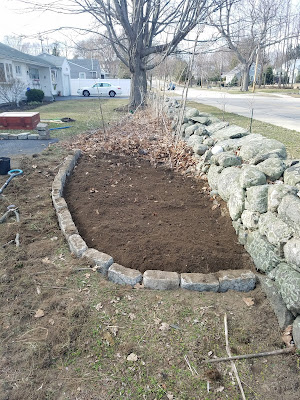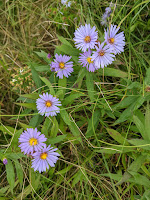Cardboard (mulch) Takes a Beating
Over the weekend I worked on my first garden project of 2019! If you read this blog, you know that I have fairly aggressive plans to add natives to my insect gardens and that means I needed to convert lawns into habitat. So far so good. I had some landscaping stones, a shovel, a rake and enough determination to take out some lawn next to the stone wall.
My plan was to remove as much of the lawn from the native soil as possible then use box cutters to cut apart cardboard that I saved from last summer when I replaced my front door. I would then get a yard of compost to put on top to start seedlings that are sitting in the cold frame and hopefully germinating soon. It seemed like a perfect plan: the cardboard would block the sun suppressing grass and weeds but would eventually decompose, giving the wildflowers one or two seasons to establish themselves.
I then read a blog post that was linked to the Native Plants of New England Facebook. The blog post was published by The Garden Professors and you can read it HERE. The authors suggested that cardboard is toxic (due to coating and glue), does not allow water to penetrate the soil and starves worms and soil organisms of oxygen, calling this mulching method the "science-free lasagna mulch method". However, in the comments below these claims were hotly debated. Some pointed out that earthworms are not native to north america at all. If used to control invasives for a year or maybe two in order to establish native vegetation, then what is the harm they ask? The Garden Professors do not answer this criticism as far as I could tell.
I will say that coated or water resistant cardboard should NEVER be used in the soil. N.H. has recently established standards for PFCs that provide that groundwater becomes contaminated and unsafe at levels of 70 parts per trillion. This standard is likely to be lowered to 38 parts per trillion this summer. The Next Generation chemicals being promoted as the replacement for teflon are actually no better. As documented in the recent film, The Devil We Know (which I highly recommend as painful as it is to watch), you should avoid these compounds whenever possible. Good luck with that, however, as it is on your ports and pans; it is in your rain resistant clothing (gore tex); it is in your dental floss; your baking sheets; and even on the tools you might buy.
But I do not believe that this cardboard is coated with PFCs. It is not water resistant and I would really like to make sure that fragments of lawn which was full of minor exotics do not take over my garden. I still have time to decide but unfortunately seeds of doubt have already been planted. What do you think? The old yankee in me comes back to the point: if it sounds easy, it is probably too good to be true.
My plan was to remove as much of the lawn from the native soil as possible then use box cutters to cut apart cardboard that I saved from last summer when I replaced my front door. I would then get a yard of compost to put on top to start seedlings that are sitting in the cold frame and hopefully germinating soon. It seemed like a perfect plan: the cardboard would block the sun suppressing grass and weeds but would eventually decompose, giving the wildflowers one or two seasons to establish themselves.
I then read a blog post that was linked to the Native Plants of New England Facebook. The blog post was published by The Garden Professors and you can read it HERE. The authors suggested that cardboard is toxic (due to coating and glue), does not allow water to penetrate the soil and starves worms and soil organisms of oxygen, calling this mulching method the "science-free lasagna mulch method". However, in the comments below these claims were hotly debated. Some pointed out that earthworms are not native to north america at all. If used to control invasives for a year or maybe two in order to establish native vegetation, then what is the harm they ask? The Garden Professors do not answer this criticism as far as I could tell.
I will say that coated or water resistant cardboard should NEVER be used in the soil. N.H. has recently established standards for PFCs that provide that groundwater becomes contaminated and unsafe at levels of 70 parts per trillion. This standard is likely to be lowered to 38 parts per trillion this summer. The Next Generation chemicals being promoted as the replacement for teflon are actually no better. As documented in the recent film, The Devil We Know (which I highly recommend as painful as it is to watch), you should avoid these compounds whenever possible. Good luck with that, however, as it is on your ports and pans; it is in your rain resistant clothing (gore tex); it is in your dental floss; your baking sheets; and even on the tools you might buy.
But I do not believe that this cardboard is coated with PFCs. It is not water resistant and I would really like to make sure that fragments of lawn which was full of minor exotics do not take over my garden. I still have time to decide but unfortunately seeds of doubt have already been planted. What do you think? The old yankee in me comes back to the point: if it sounds easy, it is probably too good to be true.





PFOA standard was set to 11 ppt in the summer of 2019.
ReplyDelete